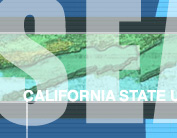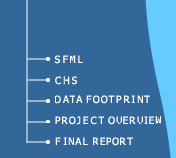


PROJECT OVERVIEW
Fisheries Habitat Characterization of the California Continental Margin: Identification, Quantification, and Synthesis of Existing Information
| National Sea Grant College Program Collaborative Project |
| #R/F-181A .PI- Dr. Gary Greene, Moss Landing Marine Laboratories. |
| #R/F-181B .PI- Dr. Rikk Kvitek, Sea Floor Mapping Lab, CSU Monterey Bay |
The 1996 reauthorization of the Magnuson-Stevens Fishery Conservation and Management Act (SFA), establishing a new focus in fisheries management, requires that regional fishery councils and the National Marine Fishery Service (NMFS) identify and designate Essential Fish Habitat (EFH) for each managed species. EFH is defined in the SFA as "waters and substrata necessary to fish for spawning, breeding, feeding or growth to maturity" and constitutes specific habitats within the total available range of a species. The SFA mandates not only the identification of habitats essential to federally managed finfish and shellfish species but also the measures necessary to conserve and enhance these habitats. After an EFH has been identified, fishery managers can use resultant habitat associations of fishes and habitat maps to formulate sustainable management plans. The protection of EFH and associated resources is accomplished through the establishment of Marine Protected Areas (MPAs), such as no-take zones and marine reserves. MPAs are promising management tools because of their potential to enhance populations of overly exploited fish and, thereby, to ultimately benefit fisheries.
Maps that identify and quantify distinct habitat types must be constructed for regions of interest, before the habitat studies necessary to determine what constitutes EFH for a particular species can be effectively conducted. Areas along the California coast in critical need of habitat data were identified at the California Marine Habitat Task Force meeting in January of 2000, hosted by the principal investigators of this project and sponsored by the California Department of Fish and Game (CDFG) and the Special Projects Office of the National Oceanographic and Atmospheric Administration (NOAA) (http://seafloor.csumb.edu/taskforce/index.html). Based on these results, multibeam bathymetric surveys were planned for the creation of habitat maps in those identified areas.
In addition, access to extensive industry side-scan sonar and other marine geologic data holdings has provided an opportunity to create habitat maps within several other nearshore regions of California. A considerable geophysical database was assembled by industry along the California margin between the 1960s and 1980s for hydrocarbon exploration. Many of these data sets are of high quality side-scan sonar mosaics, high-resolution seismic reflection profiles, and sediment data that are useful in marine benthic habitat characterization. These data are particularly valuable because it is much more difficult and expensive to collect such data today.
This project constitutes the initial stages of building a comprehensive GIS of California benthic habitats that can be used to plan and implement effective EFH programs for California. Managers and fishery scientists can now identify data voids and more capably define areas for future studies. Products from this project form the base maps upon which all other parameters, critical to the definition of a marine benthic habitat, can be overlaid and compared.
The
objectives of this project were to: 1) create digital marine benthic habitat
maps from pre-existing industry and agency data (analog side-scan sonar
mosaics and digital multibeam bathymetry imagery) representing at least
1,500 km2 of area, 2) create digital marine benthic habitat maps from
two or more newly acquired marine geophysical data sets of at least 100
km2 collected in high priority areas, 3) incorporate all digital habitat
maps, side-scan sonar mosaics, and multibeam imagery into a GIS database
that can be queried and used for fisheries management and MPA planning,
4) establish a web-based interactive GIS interface allowing public access
to the habitat maps and seafloor imagery, 5) Make the California Marine
Habitat GIS database publicly accessible as content that can be added
directly to an ArcGIS project via the SFML's Internet Map Server (IMS)
as an internet server resource, 6) make publicly available CD-ROMs that
include side-scan sonar mosaics, multibeam imagery, and interpretive habitat
maps for the cost of reproduction, 7) catalogue all available industry
data, and 8) create a report and metadata describing data, data quality,
interpretive methods, and results.
| Co-Principal Investigators |
|
Gregor Cailliet, Moss Landing Marine Laboratories |
| Mary Yoklavich, NOAA, NMFS, Southwest Fisheries Service Center |
| Churchill Grimes , NOAA, NMFS, Southwest Fisheries Service Center |
| Collaborative Partners |
| Rick Starr, University of California, Davis; (MLML) Center for Habitat Studies |
| Peter Barnes, US Geological Survey |
| Ed Saade, Racal-Pelegos, Inc. |
| Rich Slater, Delta, Inc. |